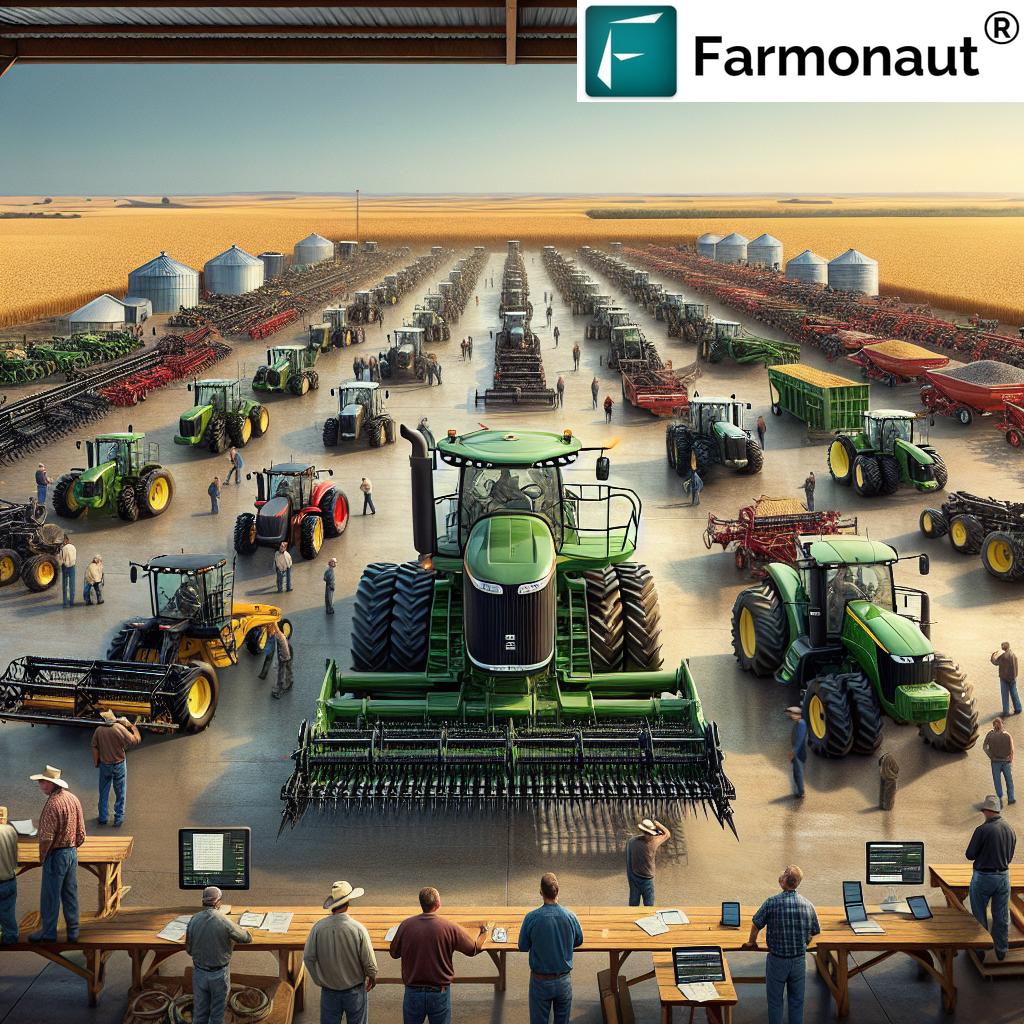Revolutionizing Precision Farming: Top Agricultural Equipment Trends and Auction Insights for US Farmers
“A 2014 MFWD tractor sold for over $65,000 at a recent high-profile agricultural equipment auction.”
Welcome to our comprehensive exploration of the latest trends in agricultural equipment and auction insights for US farmers. As we delve into the world of precision farming and cutting-edge agricultural technologies, we’ll uncover how these advancements are reshaping the landscape of modern agriculture. From the bustling agricultural equipment auctions to the innovative tools transforming crop production, we’re here to guide you through the exciting developments in the farm machinery market.
The Evolving Landscape of Agricultural Equipment Auctions
In recent years, we’ve witnessed a significant surge in activity within the agricultural equipment auction market. This trend reflects the ongoing innovation in crop production and the critical role that reliable machinery plays in today’s agriculture industry. Farmers across the USA are increasingly turning to auctions as a cost-effective strategy to upgrade their equipment and embrace cutting-edge agricultural technologies.
Let’s take a closer look at some recent high-profile sales that have caught our attention:
- A 2014 MFWD (Mechanical Front Wheel Drive) tractor sold for an impressive $65,000
- A 2006 combine harvester fetched $62,250, highlighting the strong demand for quality farm tools
These remarkable figures underscore the robust nature of the farm machinery market and the willingness of farmers to invest in tools that enhance productivity and efficiency.

Precision Farming Technology: A Game-Changer for US Agriculture
At the heart of this agricultural revolution lies precision farming technology. This innovative approach to farm management employs information technology and a wide array of items such as GPS guidance, control systems, sensors, robotics, drones, autonomous vehicles, variable rate technology, GPS-based soil sampling, and automated hardware to optimize returns on inputs while preserving resources.
Key components of precision farming include:
- GPS guidance systems for accurate planting and harvesting
- Soil sensors for real-time data on soil health and moisture levels
- Drone technology for crop monitoring and spraying
- Variable rate technology for optimized application of fertilizers and pesticides
These technologies are not just enhancing efficiency; they’re revolutionizing the way we approach agriculture in the United States.
Modern Farming Techniques: Bridging Traditional and High-Tech Agriculture
As we embrace precision farming, it’s crucial to understand how modern farming techniques are bridging the gap between traditional methods and high-tech solutions. These techniques often combine time-tested practices with cutting-edge technology to maximize yields while minimizing environmental impact.
Some of the most prominent modern farming techniques include:
- Conservation tillage to reduce soil erosion and improve soil health
- Crop rotation strategies enhanced by data analytics
- Integrated pest management using AI and machine learning
- Precision irrigation systems for optimal water usage
By adopting these techniques, US farmers are not only increasing their productivity but also contributing to more sustainable agricultural practices.
Top Agricultural Equipment Trends Shaping the Industry
As we navigate through the evolving landscape of agriculture, several equipment trends are emerging as key drivers of change. These trends are not only shaping the industry but also influencing the types of machinery that are in high demand at auctions.
- Autonomous Tractors: Self-driving tractors equipped with GPS and obstacle detection systems are becoming increasingly popular, offering precision and efficiency in field operations.
- Electric Farm Vehicles: With a focus on sustainability, electric tractors and other farm vehicles are gaining traction, promising lower operating costs and reduced emissions.
- Smart Sprayers: Advanced spraying systems use AI and computer vision to target weeds precisely, reducing herbicide use and improving crop yields.
- IoT-Enabled Equipment: Farm machinery connected to the Internet of Things (IoT) provides real-time data on performance, maintenance needs, and field conditions.
- Robotic Harvesters: Automated harvesting robots are being developed for various crops, addressing labor shortages and increasing efficiency.
These trends are reflected in the types of equipment fetching high prices at agricultural auctions across the USA.
Auction Insights: What’s Hot in the Farm Machinery Market
Our analysis of recent agricultural equipment auctions reveals some interesting insights into the current state of the farm machinery market:
- High-horsepower tractors (250+ HP) are in significant demand, especially those equipped with precision farming capabilities.
- Combine harvesters with advanced separating systems and yield monitoring technology are commanding premium prices.
- Planters and seeders with variable rate technology and section control are highly sought after.
- Used equipment in good condition is seeing strong bidding activity, as farmers look for cost-effective ways to upgrade their machinery.
These trends underscore the importance of staying informed about market dynamics when considering equipment purchases or sales.
“The robust farm machinery market saw a 2006 combine harvester fetch $62,250, demonstrating strong demand for quality equipment.”
Farm Equipment Maintenance: Ensuring Longevity and Performance
With the significant investment that farm equipment represents, proper maintenance is crucial for ensuring longevity and optimal performance. Here are some key maintenance tips for US farmers:
- Regular oil and filter changes to keep engines running smoothly
- Thorough cleaning after use to prevent corrosion and buildup
- Routine inspection of belts, hoses, and electrical systems
- Proper storage during off-seasons to protect from the elements
- Timely replacement of wear parts to prevent more significant issues
By following these maintenance practices, farmers can extend the life of their equipment and maximize their return on investment.

Agricultural Innovation Trends: Beyond Equipment
While equipment plays a crucial role in modern farming, innovation in agriculture extends far beyond machinery. Let’s explore some of the broader agricultural innovation trends shaping the industry:
- Gene Editing: CRISPR and other gene-editing technologies are being used to develop crops with improved yields, disease resistance, and nutritional profiles.
- Vertical Farming: Urban agriculture solutions are gaining popularity, allowing for year-round crop production in controlled environments.
- Blockchain in Agriculture: Blockchain technology is being utilized for supply chain traceability, ensuring food safety and transparency.
- AI-Powered Crop Management: Artificial intelligence is being employed for predictive analytics in crop management, helping farmers make data-driven decisions.
- Regenerative Agriculture: Practices that focus on soil health and carbon sequestration are gaining traction as a sustainable farming approach.
These innovations are complementing advancements in farm equipment, creating a more holistic approach to agricultural development.
Crop Production Tools: Enhancing Yield and Efficiency
In addition to large machinery, smaller crop production tools are also seeing significant advancements. These tools are essential for maximizing yield and efficiency in modern farming operations:
- Soil Testing Kits: Advanced portable soil testing equipment allows for real-time analysis of soil health and nutrient levels.
- Precision Seeders: These tools ensure optimal seed placement and spacing for improved crop emergence and yield.
- Smart Irrigation Systems: Water-efficient irrigation tools that adjust based on soil moisture levels and weather forecasts.
- Handheld Crop Sensors: Devices that measure crop health indicators like chlorophyll content and nitrogen levels.
- Automated Weather Stations: On-farm weather monitoring systems that provide localized data for decision-making.
These tools, when used in conjunction with larger equipment and precision farming techniques, can significantly boost agricultural productivity.
Farm Equipment Financing Options: Making Technology Accessible
With the high costs associated with advanced agricultural equipment, financing options play a crucial role in making these technologies accessible to farmers. Here are some common financing options available to US farmers:
- Equipment Loans: Traditional loans specifically for purchasing farm equipment, often with competitive interest rates.
- Leasing Programs: Options to lease equipment, allowing farmers to access the latest technology without a large upfront investment.
- USDA Farm Service Agency Loans: Government-backed loans designed to help farmers purchase equipment and other farm-related items.
- Vendor Financing: Many equipment manufacturers offer their own financing programs, sometimes with special promotions or rates.
- Agricultural Credit Associations: These organizations specialize in providing credit to farmers and rural communities.
By exploring these financing options, farmers can make informed decisions about upgrading their equipment and implementing new technologies.
The Role of Farmonaut in Modern Agriculture
As we discuss the latest trends in agricultural equipment and technology, it’s important to highlight how Farmonaut is contributing to this revolution in farming. Farmonaut offers advanced, satellite-based farm management solutions that complement and enhance the use of modern farm equipment.
Key features of Farmonaut’s platform include:
- Real-time crop health monitoring using satellite imagery
- AI-based advisory systems for optimized farm management
- Blockchain-based traceability for enhanced supply chain transparency
- Resource management tools to improve efficiency and sustainability
By integrating Farmonaut’s technology with modern farm equipment, farmers can achieve a new level of precision and efficiency in their operations.
Explore Farmonaut’s solutions:
For developers: Farmonaut API | API Developer Docs
Top Agricultural Equipment Auction Results
| Equipment Type | Make and Model | Year of Manufacture | Sale Price | Estimated Market Value | Price Difference (%) |
|---|---|---|---|---|---|
| Tractor | John Deere 8370R | 2014 | $65,000 | $70,000 | -7.14% |
| Combine Harvester | Case IH 7010 | 2006 | $62,250 | $58,000 | +7.33% |
| Sprayer | John Deere R4038 | 2015 | $110,000 | $105,000 | +4.76% |
| Planter | Kinze 3600 | 2012 | $45,000 | $48,000 | -6.25% |
| Tillage Equipment | Case IH True-Tandem 330 Turbo | 2018 | $55,500 | $52,000 | +6.73% |
The Future of Agriculture: Integrating Technology and Tradition
As we look to the future of agriculture in the United States, it’s clear that the integration of advanced technology with traditional farming practices will be key to meeting the challenges of food production in the 21st century. This blend of old and new is creating exciting opportunities for farmers who are willing to embrace innovation.
Some areas to watch in the coming years include:
- Further development of AI and machine learning in farm management
- Increased adoption of renewable energy sources on farms
- Advancements in biotechnology for crop and livestock improvement
- Expansion of precision agriculture techniques to smaller farms
- Greater focus on sustainable and regenerative farming practices
By staying informed about these trends and leveraging platforms like Farmonaut, US farmers can position themselves at the forefront of agricultural innovation.
Conclusion: Embracing the Agricultural Revolution
The agricultural equipment trends and auction insights we’ve explored highlight the dynamic nature of modern farming in the United States. From the robust demand for quality used equipment to the adoption of cutting-edge precision farming technologies, it’s clear that the agricultural sector is in the midst of a significant transformation.
For US farmers, staying informed about these trends and actively participating in the agricultural equipment market can lead to increased productivity, efficiency, and profitability. By combining traditional farming wisdom with innovative technologies and tools like those offered by Farmonaut, farmers can navigate the challenges of modern agriculture and contribute to a more sustainable and productive future for the industry.
As we continue to witness record-breaking sales at agricultural equipment auctions and the rapid advancement of farming technologies, one thing is certain: the future of agriculture is bright, and those who embrace these changes will be well-positioned for success in the years to come.
FAQ Section
- Q: What are the main factors driving the high demand for used farm equipment at auctions?
A: The high demand is driven by factors such as the need for cost-effective equipment upgrades, the quality of well-maintained used machinery, and the desire to access advanced technologies without the full cost of new equipment. - Q: How can precision farming technology improve crop yields?
A: Precision farming technology can improve crop yields by optimizing resource use, providing real-time data for decision-making, enabling targeted application of inputs, and reducing waste and environmental impact. - Q: What should farmers consider when financing new agricultural equipment?
A: Farmers should consider factors such as interest rates, loan terms, the expected lifespan of the equipment, potential tax benefits, and how the equipment will contribute to farm productivity and profitability. - Q: How is AI being used in modern farming practices?
A: AI is being used in various aspects of farming, including crop monitoring, predictive maintenance of equipment, automated irrigation systems, pest and disease detection, and optimizing harvest timing. - Q: What role does satellite technology play in precision agriculture?
A: Satellite technology plays a crucial role in precision agriculture by providing accurate field mapping, monitoring crop health through vegetation indices, tracking weather patterns, and enabling precise GPS guidance for farm equipment.




















